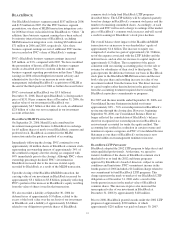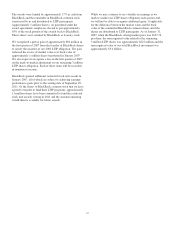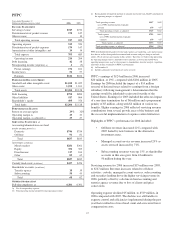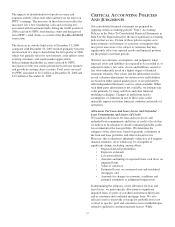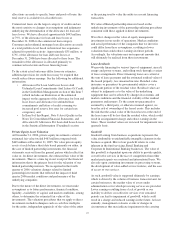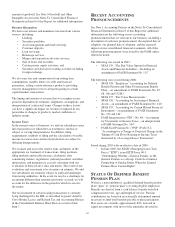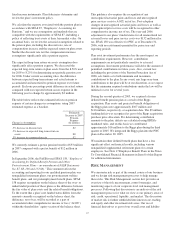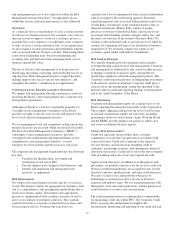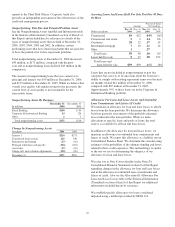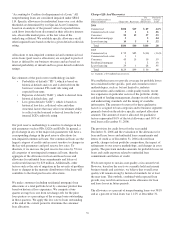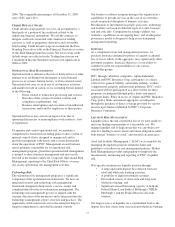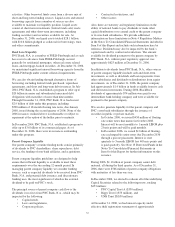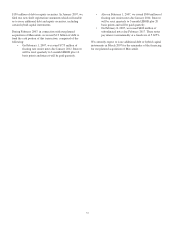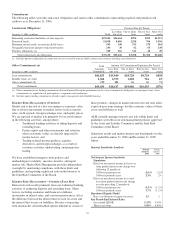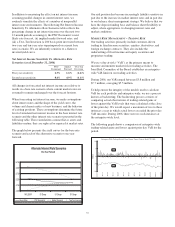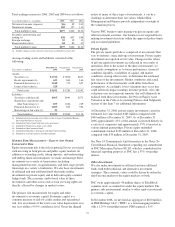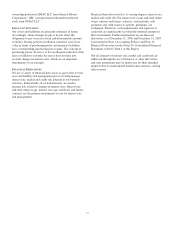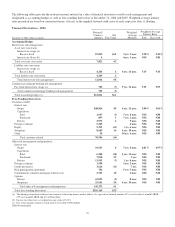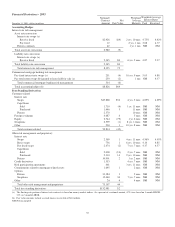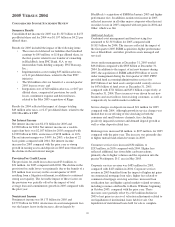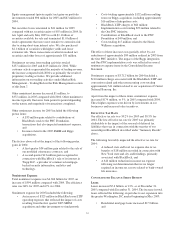PNC Bank 2006 Annual Report Download - page 61
Download and view the complete annual report
Please find page 61 of the 2006 PNC Bank annual report below. You can navigate through the pages in the report by either clicking on the pages listed below, or by using the keyword search tool below to find specific information within the annual report.2006. The comparable percentages at December 31, 2005
were 314% and 1.21%.
C
REDIT
D
EFAULT
S
WAPS
Credit default swaps provide, for a fee, an assumption by a
third party of a portion of the credit risk related to the
underlying financial instruments. We use the contracts to
mitigate credit risk associated with commercial lending
activities as well as proprietary derivative and convertible
bond trading. Credit default swaps are included in the Free-
Standing Derivatives table in the Financial Derivatives section
of this Risk Management discussion. Net losses from credit
default swaps are reflected in the Trading line item on our
Consolidated Income Statement and were not significant in
2006 or 2005.
O
PERATIONAL
R
ISK
M
ANAGEMENT
Operational risk is defined as the risk of financial loss or other
damage to us resulting from inadequate or failed internal
processes or systems, human factors, or from external events.
Operational risk may occur in any of our business activities
and manifests itself in various ways, including but not limited
to the following:
• Errors related to transaction processing and systems,
• Breaches of the system of internal controls and
compliance requirements, and
• Business interruptions and execution of unauthorized
transactions and fraud by employees or third parties.
Operational losses may arise from legal actions due to
operating deficiencies or noncompliance with contracts, laws
or regulations.
To monitor and control operational risk, we maintain a
comprehensive framework including policies and a system of
internal controls that is designed to manage risk and to
provide management with timely and accurate information
about the operations of PNC. Management at each business
unit is primarily responsible for its operational risk
management program, given that operational risk management
is integral to direct business management and most easily
effected at the business unit level. Corporate Operational Risk
Management, reporting to the Chief Risk Officer, oversees
day-to-day operational risk management activities.
Technology Risk
The technology risk management program is a significant
component of the operational risk framework. We have an
integrated security and technology risk management
framework designed to help ensure a secure, sound, and
compliant infrastructure for information management. The
technology risk management process is aligned with the
strategic direction of the businesses and is integrated into the
technology management culture, structure and practices. The
application of this framework across the enterprise helps to
support comprehensive and reliable internal controls.
Our business resiliency program manages the organization’s
capabilities to provide services in the case of an event that
results in material disruption of business activities.
Prioritization of investments in people, processes, technology
and facilities are based on different types of events, business
risk and criticality. Comprehensive testing validates our
resiliency capabilities on an ongoing basis, and an integrated
governance model is designed to help assure transparent
management reporting.
Insurance
As a component of our risk management practices, we
purchase insurance designed to protect us against accidental
loss or losses which, in the aggregate, may significantly affect
personnel, property, financial objectives, or our ability to
continue to meet our responsibilities to our various
stakeholder groups.
PNC, through subsidiary companies, Alpine Indemnity
Limited and PNC Insurance Corp., participates as a direct
writer for its general liability, automobile liability, workers’
compensation, property and terrorism programs. PNC’s risks
associated with its participation as a direct writer for these
programs are mitigated through policy limits and annual
aggregate limits. Risks in excess of Alpine and PNC Insurance
Corp. policy limits and annual aggregates are mitigated
through the purchase of direct coverage provided by various
insurers up to limits established by PNC’s Corporate
Insurance Committee.
L
IQUIDITY
R
ISK
M
ANAGEMENT
Liquidity risk is the risk of potential loss if we were unable to
meet our funding requirements at a reasonable cost. We
manage liquidity risk to help ensure that we can obtain cost-
effective funding to meet current and future obligations under
both normal “business as usual” and stressful circumstances.
Asset and Liability Management (“ALM”) is accountable for
managing the liquidity position within the limits and
guidelines set forth in our risk management policies. Market
Risk Management provides independent oversight for the
measurement, monitoring and reporting of PNC’s liquidity
risk.
We typically maintain our liquidity position through:
• A large and stable deposit base derived from our
retail and wholesale banking activities,
• A portfolio of liquid investment securities,
• Diversified sources of short-term and long-term
wholesale funding, and
• Significant unused borrowing capacity at both the
Federal Home Loan Bank of Pittsburgh (“FHLB-
Pittsburgh”) and the Federal Reserve discount
window.
Our largest source of liquidity on a consolidated basis is the
deposit base that comes from our retail and wholesale banking
51


